SBAS484B September 2010 – December 2016 TSC2014
PRODUCTION DATA.
- 1 Features
- 2 Applications
- 3 Description
- 4 Revision History
- 5 Pin Configuration and Functions
-
6 Electrical Specifications
- 6.1 Absolute Maximum Ratings
- 6.2 ESD Ratings
- 6.3 Thermal Information
- 6.4 Recommended Operating Conditions
- 6.5 Electrical Characteristics
- 6.6 Timing Requirements for : I2C Standard Mode (fSCL = 100 kHz)
- 6.7 Timing Requirements for : I2C Fast Mode (fSCL = 400 kHz)
- 6.8 Timing Requirements for : I2C High-Speed Mode (fSCL = 1.7 MHz)
- 6.9 Timing Requirements for : I2C High-Speed Mode (fSCL = 3.4 MHz)
- 6.10 Timing Information
- 6.11 Typical Characteristics
-
7 Detailed Description
- 7.1 Overview
- 7.2 Functional Block Diagram
- 7.3 Feature Description
- 7.4 Device Functional Modes
- 7.5 Programming
- 7.6
Register Maps
- 7.6.1 R/W
- 7.6.2 Control Byte 0
- 7.6.3 Control Byte 1
- 7.6.4 Communication Protocol
- 7.6.5 Configuration Register 2
- 7.6.6 Converter Function Select Register
- 7.6.7 Data Registers
- 8 Application and Implementation
- 9 Power Supply Recommendations
- 10Layout
- 11Device and Documentation Support
- 12Mechanical, Packaging, and Orderable Information
6 Electrical Specifications
6.1 Absolute Maximum Ratings(1)
Over operating free-air temperature range (unless otherwise noted).| MIN | MAX | UNIT | |||
|---|---|---|---|---|---|
| Voltage range | Analog input X+, Y+, AUX to GND | –0.4 | VDD + 0.1 | V | |
| Analog input X–, Y– to GND | –0.4 | VDD + 0.1 | V | ||
| VDD/REF pin to GND | –0. | 5 | V | ||
| Digital input voltage to GND | –0. | VDD + 0.3 | V | ||
| Digital output voltage to GND | –0. | VDD + 0.3 | V | ||
| Operating free-air temperature range, TA | –40 | 85 | °C | ||
| Storage temperature range, TSTG | –65 | 150 | °C | ||
| Junction temperature, TJ Max | 150 | °C | |||
(1) Stresses beyond those listed under Absolute Maximum Ratings may cause permanent damage to the device. These are stress ratings only, and functional operation of the device at these or any other conditions beyond those indicated is not implied. Exposure to absolute-maximum rated conditions for extended periods may affect device reliability.
6.2 ESD Ratings
| VALUE | UNIT | |||
|---|---|---|---|---|
| V(ESD) | Electrostatic discharge | Human-body model (HBM), per ANSI/ESDA/JEDEC JS-001(1) | ±2000 | V |
| Charged-device model (CDM), per JEDEC specification JESD22-C101(2) | ±500 | |||
(1) JEDEC document JEP155 states that 500-V HBM allows safe manufacturing with a standard ESD control process.
(2) JEDEC document JEP157 states that 250-V CDM allows safe manufacturing with a standard ESD control process.
6.3 Thermal Information
| THERMAL METRIC(1) | TSC2014 | UNIT | |
|---|---|---|---|
| YZG (DSBGA) | |||
| 12 PINS | |||
| θJA | Junction-to-ambient thermal resistance | 115 | °C/W |
| θJCtop | Junction-to-case (top) thermal resistance | 30 | °C/W |
| θJB | Junction-to-board thermal resistance | 82 | °C/W |
| ψJT | Junction-to-top characterization parameter | 5 | °C/W |
| ψJB | Junction-to-board characterization parameter | 75 | °C/W |
| θJCbot | Junction-to-case (bottom) thermal resistance | — | |
(1)
6.4 Recommended Operating Conditions
over operating free-air temperature range (unless otherwise noted)| MIN | NOM | MAX | UNIT | ||
|---|---|---|---|---|---|
| Power Supply, VDD/REF | 1.2 | 3.3 | 3.6 | V | |
| TA | Operating free-air temperature | –40 | 85 | °C | |
6.5 Electrical Characteristics
At TA = –40°C to +85°C, VDD = +1.2V to +3.6V, unless otherwise noted.| PARAMETER | TEST CONDITIONS | TSC2014 | UNIT | ||||
|---|---|---|---|---|---|---|---|
| MIN | TYP | MAX | |||||
| AUXILIARY ANALOG INPUT | |||||||
| Input voltage range | 0 | VDD | V | ||||
| Input capacitance | 12 | pF | |||||
| Input leakage current | –1 | +1 | μA | ||||
| Full-scale average input current | VDD = 1.6V, continuous AUX | 2 | μA | ||||
| A/D CONVERTER | |||||||
| Resolution | Programmable: 10 or 12 bits | 12 | Bits | ||||
| No missing codes | 12-bit resolution | 11 | Bits | ||||
| Integral linearity | –3 | –0.6 to +0.38 | +3 | LSB(1) | |||
| Differential linearity | –2 | –0.46 to +0.49 | +4 | LSB | |||
| Offset error | VDD = 1.6V | –5 | 0.53 | +5 | LSB | ||
| Gain error | VDD = 1.6V | –3 | 0.32 | +3 | LSB | ||
| TOUCH SENSORS | |||||||
| PENIRQ 50kΩ pull-up resistor, RIRQ | TA = +25°C, VDD = 1.6V | 50 | kΩ | ||||
| X, Y drivers on-resistance | Y+, X+ | TA = +25°C, VDD = 1.6V | 6 | Ω | |||
| Y–, X– | TA = +25°C, VDD = 1.6V | 4.5 | Ω | ||||
| X, Y drivers drive current(2) | 100ms duration | 50 | mA | ||||
| INTERNAL TEMPERATURE SENSOR | |||||||
| Temperature range | –40 | +85 | °C | ||||
| Resolution | Differential method(3) | VDD = 1.6V | 0.3 | °C/LSB | |||
| VDD = 3V | 1.6 | °C/LSB | |||||
| TEMP1(4) | VDD = 1.6V | 0.3 | °C/LSB | ||||
| VDD = 3V | 1.6 | °C/LSB | |||||
| Accuracy | Differential method(3) | VDD = 1.6V | ±3 | °C/LSB | |||
| VDD = 3V | ±2 | °C/LSB | |||||
| TEMP1(4) | VDD = 1.6V | ±3 | °C/LSB | ||||
| VDD = 3V | ±2 | °C/LSB | |||||
| INTERNAL OSCILLATOR | |||||||
| Clock frequency, fOSC | VDD = 1.2V, TA = +25°C | 3.3 | MHz | ||||
| VDD = 1.6V | 3.3 | 3.82 | 4.3 | MHz | |||
| VDD = 3.0V, TA = +25°C | 4.1 | MHz | |||||
| Frequency drift | VDD = 1.2V | 0.121 | %/°C | ||||
| VDD = 1.6V | –0.013 | %/°C | |||||
| VDD = 3.0V | –0.028 | %/°C | |||||
| DIGITAL INPUT/OUTPUT | |||||||
| Logic family | CMOS | ||||||
| Logic level | VIH | 1.2V ≤ VDD < 1.6V | 0.7 × VDD | VDD + 0.3 | V | ||
| 1.6V ≤ VDD ≤ 3.6V | 0.7 × VDD | VDD + 0.3 | V | ||||
| VIL | 1.2V ≤ VDD < 1.6V | –0.3 | 0.2 × VDD | V | |||
| 1.6V ≤ VDD ≤ 3.6V | –0.3 | 0.3 × VDD | V | ||||
| IIL | SCL and SDA pins | –1 | 1 | μA | |||
| CIN | SCL and SDA pins | 10 | pF | ||||
| VOH | IOH = 2 TTL loads | VDD – 0.2 | VDD | V | |||
| VOL | IOL = 2 TTL loads | 0 | 0.2 | V | |||
| ILEAK | Floating output | –1 | 1 | μA | |||
| COUT | Floating output | 10 | pF | ||||
| Data format | Straight Binary | ||||||
| POWER-SUPPLY REQUIREMENTS | |||||||
| Power-supply voltage | |||||||
| VDD | Specified performance | 1.2 | 3.6 | V | |||
| Quiescent supply current (5) | Filter off, M = W = 1, C[3:0] = (1,0,0,0), RM = 1, CL[1:0] = (0,1), cont AUX mode, fADC = 2MHz, without reading data register | VDD = 1.6V | 420 | 570 | μA | ||
| TA = +25°C, filter on, M = 15, W = 7, PSM = 1, C[3:0] = (0,0,0,0), RM = 1, CL[1:0] = (0,1), BTD[2:0] = (1,0,1), 50SSPS, MAVEX = MAVEY = MAVEZ = 1, fADC = 2MHz, High-Speed mode, sensor drivers supply included(6) | VDD = 1.2V | 156 | μA | ||||
| VDD = 1.6V | 200 | μA | |||||
| VDD = 3.0V | 400 | μA | |||||
| TA = +25°C, filter off, M = W = 1, PSM = 1, C[3:0] = (0,0,0,0), RM = 1, CL[1:0] = (0,1), BTD[2:0] = (1,0,1), 50SSPS, MAVEX = MAVEY = MAVEZ = 1, fADC = 2MHz, High-Speed mode, sensor drivers supply included(6) | VDD = 1.2V | 140 | μA | ||||
| VDD = 1.6V | 180 | μA | |||||
| VDD = 3.0V | 370 | μA | |||||
| TA = +25°C, filter off, M = W = 1, C[3:0] = (0,1,0,1), RM = 1, CL[1:0] = (0,1), non-cont AUX mode, fADC = 2MHz, High-Speed mode | VDD = 1.2V, ~27.2kSPS effective rate | 150 | μA | ||||
| VDD = 1.6V, ~28.6kSPS effective rate | 200 | μA | |||||
| VDD = 3.0V, ~29.1kSPS effective rate | 390 | μA | |||||
| TA = +25°C, filter on, M = 7, W = 3, C[3:0] = (0,1,0,1), RM = 1, CL[1:0] = (0,1), MAVEAUX = 1, non-cont AUX mode, fADC = 2MHz, High-Speed mode, full speed | VDD = 1.2V, ~10.3kSPS effective rate | 272 | μA | ||||
| VDD = 1.6V, ~11.8kSPS effective rate | 365 | μA | |||||
| VDD = 3.0V, ~12.3kSPS effective rate | 683 | μA | |||||
| TA = +25°C, filter on, M = 7, W = 3, C[3:0] = (0,1,0,1), RM = 1, CL[1:0] = (0,1), MAVEAUX = 1, non-cont AUX mode, fADC = 2MHz, High-Speed mode, reduced speed (8.2kSPS equivalent rate) | VDD = 1.2V, ~1.17kSPS effective rate | 30.9 | μA | ||||
| VDD = 1.6V, ~1.17kSPS effective rate | 36.2 | μA | |||||
| VDD = 3.0V, ~1.17kSPS effective rate | 64.9 | μA | |||||
| Power-down supply current | TA = +25°C, Not addressed, SCL = SDA = 1, VDD = 1.6V, RESET = 1, PINTDAV = 1 | 0.023 | 0.8 | μA | |||
(1) LSB means Least Significant Bit. With VREF = +2.5V, one LSB is 610μV.
(2) Assured by design, but not tested. Exceeding 50mA source current may result in device degradation.
(3) Difference between TEMP1 and TEMP2 measurement; no calibration necessary.
(4) Temperature drift is –2.1mV/°C, TEMP2 drift is –1.7mV/°C.
(5) For detailed information on test condition parameter and bit settings, see the section.
(6) Touch sensor modeled by: 2kΩ for X-plane and Y-plane, and 1kΩ for Z (touch resistance).
6.6 Timing Requirements for Figure 1: I2C Standard Mode (fSCL = 100 kHz)
All specifications typical at –40°C to +85°C, VDD = +1.2V to +3.6V, unless otherwise noted.| TWO-WIRE STANDARD MODE PARAMETERS | TEST CONDITIONS | MIN | MAX | UNIT | |
|---|---|---|---|---|---|
| Reset low time(1) | tWL(RESET) | VDD ≥ 1.6V | 10 | μs | |
| 1.2V ≤ VDD < 1.6V | 13 | μs | |||
| SCL clock frequency | fSCL | 100 | kHz | ||
| Bus free time between a STOP and START condition | tBUF | 4.7 | μs | ||
| Hold time (repeated) START condition | tHD, STA | 4.0 | μs | ||
| Low period of SCL clock | tLOW | 4.7 | μs | ||
| High period of the SCL clock | tHIGH | 4.0 | μs | ||
| Setup time for a repeated START condition | tSU, STA | 4.7 | μs | ||
| Data hold time | tHD, DAT | 0 | 3.45 | μs | |
| Data setup time | tSU, DAT | 250 | ns | ||
| Rise time of both SDA and SCL signals | tR | Cb = total bus capacitance | 1000 | ns | |
| Fall time of both SDA and SCL signals | tF | Cb = total bus capacitance | 300 | ns | |
| Setup time for STOP condition | tSU, STO | 4.0 | μs | ||
| Capacitive load for each bus line | Cb | Cb = total capacitance of one bus line in pF | 400 | pF | |
| Pulse width of spike suppressed | tSP | N/A | N/A | ns | |
(1) Refer to Figure 36.
6.7 Timing Requirements for Figure 1: I2C Fast Mode (fSCL = 400 kHz)
All specifications typical at –40°C to +85°C, VDD = +1.2V to +3.6V, unless otherwise noted.| TWO-WIRE FAST MODE PARAMETERS | TEST CONDITIONS | MIN | MAX | UNIT | |
|---|---|---|---|---|---|
| Reset low time(1) | tWL(RESET) | VDD ≥ 1.6V | 10 | μs | |
| 1.2V ≤ VDD < 1.6V | 13 | μs | |||
| SCL clock frequency | fSCL | 400 | kHz | ||
| Bus free time between a STOP and START condition | tBUF | 1.3 | μs | ||
| Hold time (repeated) START condition | tHD, STA | 0.6 | μs | ||
| Low period of SCL clock | tLOW | 1.3 | μs | ||
| High period of the SCL clock | tHIGH | 0.6 | μs | ||
| Setup time for a repeated START condition | tSU, STA | 0.6 | μs | ||
| Data hold time | tHD, DAT | 0 | 0.9 | μs | |
| Data setup time | tSU, DAT | 100 | ns | ||
| Rise time of both SDA and SCL signals | tR | Cb = total bus capacitance | 20 + 0.1 × Cb | 300 | ns |
| Fall time of both SDA and SCL signals(2) | tF | Cb = total bus capacitance | 20 + 0.1 × Cb | 300 | ns |
| Setup time for STOP condition | tSU, STO | 0.6 | μs | ||
| Capacitive load for each bus line | Cb | Cb = total capacitance of one bus line in pF | 400 | pF | |
| Pulse width of spike suppressed | tSP | 0 | 50 | ns | |
(1) Refer to Figure 36.
(2) Cb = the total capacitance of one bus line in pF. If using both Fast mode and Hs-mode devices, faster fall times according to the 3.4MHz High-Speed Mode table are allowed. Note that the TSC2014 is a Hs-mode device and follows the I2C, 3.4MHz, High-Speed Mode table requirements.
6.8 Timing Requirements for Figure 2: I2C High-Speed Mode (fSCL = 1.7 MHz)
All specifications typical at –40°C to +85°C, VDD = +1.2V to +3.6V, unless otherwise noted.| TWO-WIRE HIGH-SPEED MODE PARAMETERS | TEST CONDITIONS | MIN | MAX | UNIT | |
|---|---|---|---|---|---|
| Reset low time(1) | tWL(RESET) | VDD ≥ 1.6V | 10 | μs | |
| 1.2V ≤ VDD < 1.6V | 13 | μs | |||
| SCL clock frequency | fSCL | 1.7 | MHz | ||
| Hold time (repeated) START condition | tHD, STA | 160 | ns | ||
| Low period of SCL clock | tLOW | 320 | ns | ||
| High period of the SCL clock | tHIGH | 120 | ns | ||
| Setup time for a repeated START condition | tSU, STA | 160 | ns | ||
| Data hold time | tHD, DAT | 0 | 150 | ns | |
| Data setup time | tSU, DAT | 10 | ns | ||
| Rise time of SCL signal | tRCL | Cb = total bus capacitance(2) | 20 | 80 | ns |
| Rise time of SDA signal | tRDA | Cb = total bus capacitance(2) | 20 | 160 | ns |
| Fall time of SCL signal | tFCL | Cb = total bus capacitance(2) | 20 | 80 | ns |
| Fall time of SDA signal | tFDA | Cb = total bus capacitance(2) | 1 | 160 | ns |
| Rise time of SCL signal after a repeated START condition and after an acknowledge bit | tRCL1 | Cb = total bus capacitance(2) | 20 | 160 | ns |
| Setup time for STOP condition | tSU, STO | 160 | ns | ||
| Capacitive load for each bus line | Cb | Cb = total capacitance of one bus line in pF | 400 | pF | |
| Pulse width of spike suppressed | tSP | 0 | 10 | ns | |
(1) Refer to Figure 36.
(2) For capacitive bus loads between 100pF and 400pF, the rise and fall time values must be linearly interpolated.
6.9 Timing Requirements for Figure 2: I2C High-Speed Mode (fSCL = 3.4 MHz)
All specifications typical at –40°C to +85°C, VDD = +1.2V(2) to +3.6V, unless otherwise noted.| TWO-WIRE HIGH-SPEED MODE PARAMETERS | TEST CONDITIONS | MIN | MAX | UNIT | |
|---|---|---|---|---|---|
| Reset low time(1) | tWL(RESET) | VDD ≥ 1.6V | 10 | μs | |
| 1.2V ≤ VDD < 1.6V | 13 | μs | |||
| SCL clock frequency | fSCL | 3.4 | MHz | ||
| Hold time (repeated) START condition | tHD, STA | 160 | ns | ||
| Low period of SCL clock | tLOW | 160 | ns | ||
| High period of the SCL clock | tHIGH | 60 | ns | ||
| Setup time for a repeated START condition | tSU, STA | 160 | ns | ||
| Data hold time | tHD, DAT | 0 | 70 | ns | |
| Data setup time | tSU, DAT | 10 | ns | ||
| Rise time of SCL signal | tRCL | Cb = total bus capacitance(3) | 10 | 40 | ns |
| Rise time of SDA signal | tRDA | Cb = total bus capacitance(3) | 10 | 80 | ns |
| Fall time of SCL signal | tFCL | Cb = total bus capacitance(3) | 10 | 40 | ns |
| Fall time of SDA signal | tFDA | Cb = total bus capacitance(3) | 1 | 80 | ns |
| Rise time of SCL signal after a repeated START condition and after an acknowledge bit | tRCL1 | Cb = total bus capacitance(3) | 10 | 80 | ns |
| Setup time for STOP condition | tSU, STO | 160 | ns | ||
| Capacitive load for each bus line | Cb | Cb = total capacitance of one bus line in pF | 100 | pF | |
| Pulse width of spike suppressed | tSP | 0 | 10 | ns | |
(1) Refer to Figure 36.
(2) Because of the low supply voltage of 1.2V and the wide temperature range of –40°C to +85°C, the I2C system devices may not reach the maximum specification of I2C High-Speed mode, and fSCL may not reach 3.4MHz.
(3) Capacitive load from 10pF to 100pF.
6.10 Timing Information
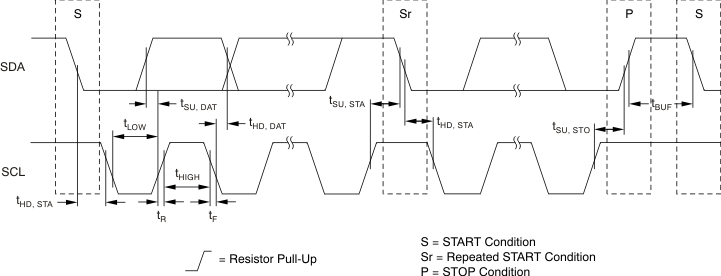 Figure 1. Detailed I/O Timing for Standard and Fast Modes
Figure 1. Detailed I/O Timing for Standard and Fast Modes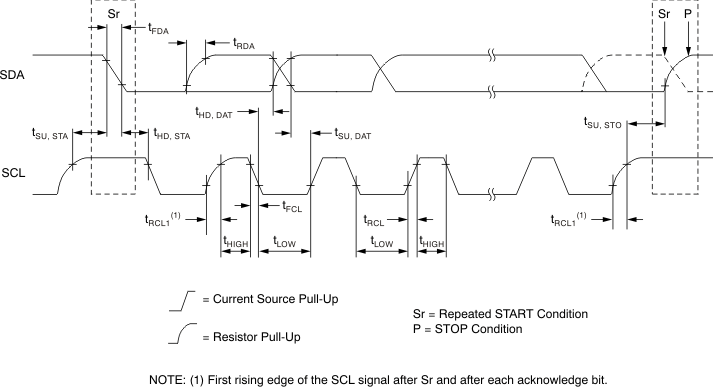 Figure 2. Detailed I/O Timing for High-Speed Mode
Figure 2. Detailed I/O Timing for High-Speed Mode
6.11 Typical Characteristics
At TA = –40°C to +85°C, VDD = +1.2V to +3.6V, fADC = fOSC/2,High-Speed mode (fSCL = 3.4MHz), 12-bit mode, and non-continuous AUX measurement, unless otherwise noted.
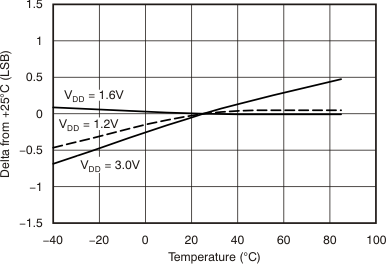 Figure 3. Change in Offset vs Temperature
Figure 3. Change in Offset vs Temperature
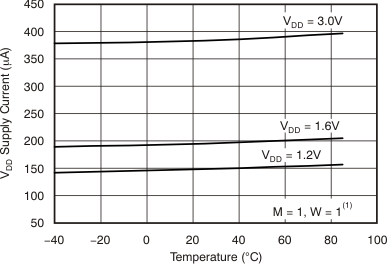 Figure 5. VDD Supply Current vs Temperature
Figure 5. VDD Supply Current vs Temperature
 Figure 7. VDD Supply Current vs VDD Supply Voltage
Figure 7. VDD Supply Current vs VDD Supply Voltage
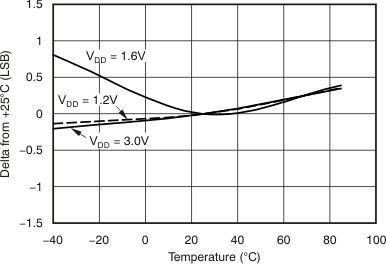 Figure 4. Change in Gain vs Temperature
Figure 4. Change in Gain vs Temperature
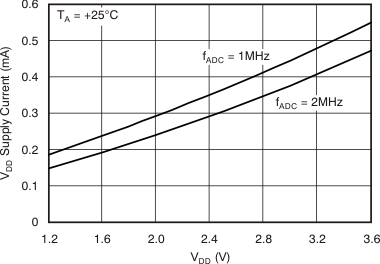 Figure 6. VDD Supply Current vs
Figure 6. VDD Supply Current vs VDD Supply Voltage
 Figure 8. Power-down Supply Current vs Temperature
Figure 8. Power-down Supply Current vs Temperature
 Figure 10. Switch-on Resistance (XN, YN) vs
Figure 10. Switch-on Resistance (XN, YN) vs VDD Supply Voltage
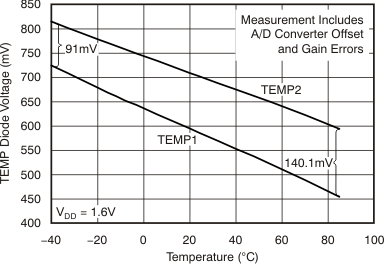 Figure 12. Temp Diode Voltage vs Temperature
Figure 12. Temp Diode Voltage vs Temperature
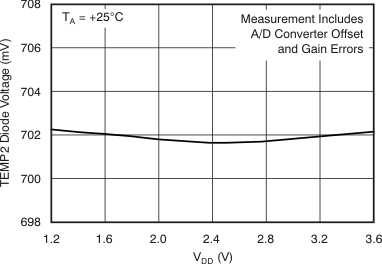 Figure 14. TEMP2 Diode Voltage vs
Figure 14. TEMP2 Diode Voltage vs VDD Supply Voltage
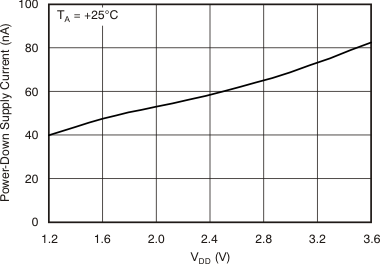 Figure 9. Power-down Supply Current vs VDD
Figure 9. Power-down Supply Current vs VDD
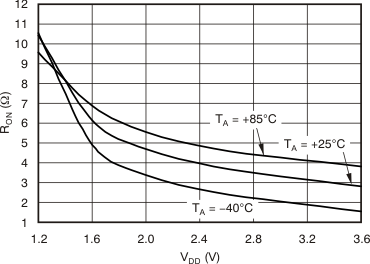 Figure 11. Switch-on Resistance (XP, YP) vs
Figure 11. Switch-on Resistance (XP, YP) vs VDD Supply Voltage
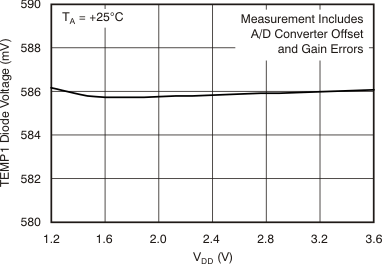 Figure 13. TEMP1 Diode Voltage vs
Figure 13. TEMP1 Diode Voltage vs VDD Supply Voltage
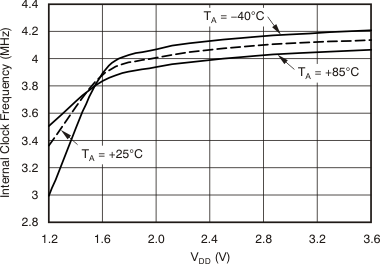 Figure 15. Internal Oscillator Clock Frequency vs
Figure 15. Internal Oscillator Clock Frequency vs VDD Supply Voltage